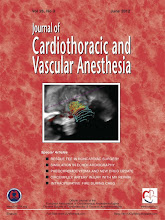E-CHALLENGES & CLINICAL DECISIONS
Feroze Mahmood, MD Madhav Swaminathan, MD
Section Editors
Percutaneous Closure of an Atrial Septal Defect and 3-Dimensional Echocardiography
Faraz Mahmood, BA,*† Omair Shakil, MD,*† Jeniffer R. Gerstle, MD,*† and Robina Matyal, MD*†
AN OTHERWISE HEALTHY 50-year-old man was scheduled for percutaneous atrial septal defect (ASD) closure with an Amplatzer Septal Occluder (AGA Medical Corp, Plymouth, MN). The patient initially had presented to an outside hospital 1 year earlier with an episode of chest pain at rest. A chest x-ray performed during that admission showed a widened mediastinum. A subsequent computed tomography scan and transthoracic echocardiogram (TTE) revealed a 2.1-cm wide secundum ASD (Fig 1) with a dilated right ventricle and moderately dilated right and left atria. The patient did not follow through with recommendations for a TEE and possible ASD closure and was lost to follow-up. A year later, he returned to the authors’ institution with a 6-month long history of dyspnea and episodic chest pain with moderate exertion that was relieved by rest. He underwent cardiac catheterization to assess for the presence of coronary artery disease, but which was negative for any flow-limiting lesions. Resting hemodynamics revealed normal right-sided pressures, and oxygen saturation measurements that were consistent with a left-to-right shunt (Qp/Qs [H11005] 2.4). He subsequently was referred for ASD closure under TEE guidance. After an uneventful induction of general anesthesia, a TEE examination was performed using an IE-33 Ultrasound System X7-2E Probe (Philips Medical Systems, Andover, MA) capable of real-time 3-dimensional (3D) imaging.
ECHOCARDIOGRAPHIC FINDINGS
The preliminary TEE examination revealed a 2.1-cm (edge-to-edge) wide secundum ASD (Fig 1). A left-to-right shunt with a large flow across the interatrial septum was detected, and the right atrium was also dilated; the left atrium was normal in size. Although the right ventricular cavity was dilated, the overall left ventricular systolic function was normal (left ventricular ejection fraction [H11022]55%). Mild mitral regurgitation ([H11001]1) was noted, but the aortic and mitral leaflets appeared structurally normal. No spontaneous echocardiographic
contrast or thrombi were seen in the left atrium, the right atrium, or the left and right atrial appendages. There was also a small patent foramen ovale along the inferior edge of the interatrial septum with a left-to-right shunt. The edge of the secundum ASD were seen to consist of a thin mobile filamentous tissue (Video 1 supplementary videos are available online]).
Video 1
CLINICAL CHALLENGES
Although the procedure itself was relatively uncomplicated, the clinical team faced considerable difficulty in the deployment of the Amplatzer device and its seating. Initially, a size 22 Amplatzer device was percutaneously deployed across the ASD, but TEE imaging showed significant residual left-to-right shunting, and the device was assessed to be mechanically insecure in that it was not well seated on the relatively large ASD. As a result, this device was removed (Video 2). Next, a larger, 24-mm Amplatzer device was deployed with some reduction in residual shunting, but the mechanical seating of the device was again evaluated to be insecure with a likelihood of dislodgement (Video 2).
Video 2
The clinical challenges encountered during the case were as follows: (1) Has the ASD size been measured accurately? (2) Should the thin and mobile portion of the ASD be excluded from ascertaining the ASD diameter? and (3) Would a larger device be suitable for this ASD?
From the *Department of Anesthesia, Critical Care and Pain Medicine, Beth Israel Deaconess Medical Center, Boston, MA; and †Harvard Medical School, Boston, MA.
Address reprint requests to Omair Shakil, MD, Department of Anesthesia, Critical Care and Pain Medicine, Beth Israel Deaconess Medical Center, One Deaconess Road, CC-470, Boston, MA 02215. E-mail: oshakil@bidmc.harvard.edu
© 2013 Elsevier Inc. All rights reserved. 1053-0770/2702-0001$36.00/0 http://dx.doi.org/10.1053/j.jvca.2012.09.016
Key words: atrial septal defect, 3-dimensional transesophageal echocardiography, Amplatzer device
Key words: atrial septal defect, 3-dimensional transesophageal echocardiography, Amplatzer device
Fig 1. The ASD had a diameter of 2.1 cm on 2-dimensional transesophageal echocardiography. RA, right atrium; LA, left atrium. (Color version of figure is available online.)
400 Journal of Cardiothoracic and Vascular Anesthesia, Vol 27, No 2 (April), 2013: pp 400-401
PERCUTANEOUS CLOSURE OF AN ASD
Fig 2. MPRF of volumetric data acquired during transesophageal echocardiography confirmed the diameter of the ASD to be 3.4 cm. (Color version of figure is available online.)
ECHOCARDIOGRAPHIC ANALYSIS
At this point, the size of the ASD was measured again using the multiplanar reformatting (MPRF) of the volumetric 3D data acquired during the TEE examination. Using the 3D quantification function of the Q-Lab software (Philips Medical Systems), the filamentous tissue of the ASD was excluded from the measurement of the diameter (Fig 2). The diameter obtained
For further information and follow-up discussion of the E-Challenge, please go to:
(1) JCVA online web page for the video images at www.JCVAonline.com
(2) JCVA blog site for adding your comments or for viewing the other responses: http://JCVAblog.blogspot.com
(1) JCVA online web page for the video images at www.JCVAonline.com
(2) JCVA blog site for adding your comments or for viewing the other responses: http://JCVAblog.blogspot.com
BLOG




No comments:
Post a Comment